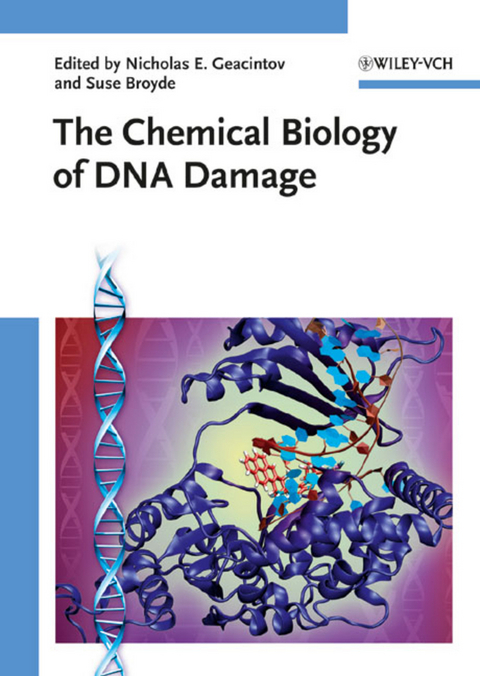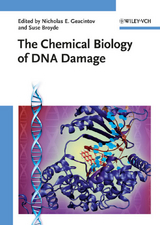The Chemical Biology of DNA Damage
Wiley-VCH (Verlag)
978-3-527-32295-4 (ISBN)
- Titel ist leider vergriffen;
keine Neuauflage - Artikel merken
Nicholas E. Geacintov is Professor of Chemistry and former Chair of the Department of Chemistry at New York University (NYU), USA. He received his PhD degree in physical chemistry and polymer chemistry from the State University of New York College of Forestry at Syracuse University, and spent most of his career at NYU. His current research interests are focused on the mechanisms of chemical carcinogenesis and oxidatively generated DNA damage, especially the relationships between the structural features of DNA lesions and their impact on DNA repair and replication. He has published over 350 papers and is currently serving as a member of the Editorial Board of the Journal of Biological Chemistry. Suse Broyde is Professor of Biology and Affiliate Professor of Chemistry at New York University, USA. Her research interests are focused on computer modeling of DNA lesions, with the goal of elucidating the molecular origins of their mutagenic and tumorigenic properties. She holds a PhD degree in physical chemistry with a minor in physics from the Polytechnic Institute of New York, and has published over 160 papers in peer-reviewed journals. She has been a member of the Editorial Advisory Board of Chemical Research in Toxicology.
Preface
PART I: Chemistry and Biology of DNA Lesions
INTRODUCTION AND PERSPECTIVES ON THE CHEMISTRY AND BIOLOGY OF DNA DAMAGE
Overview of the Field
DNA Damage ¿ A Constant Threat
DNA Damage and Disease
DNA Damage and Chemotherapeutic Applications
The Cellular DNA Damage Response (DDR)
Repair Mechanisms that Remove DNA Lesions
Relationships between the Chemical, Structural, and Biological Features of DNA Lesions
CHEMISTRY OF INFLAMMATION AND DNA DAMAGE: BIOLOGICAL IMPACT OF REACTIVE NITROGEN SPECIES
Introduction
DNA Oxidation and Nitration
DNA Deamination
2¿-Deoxyribose Oxidation
Indirect Base Damage Caused by RNS
Conclusions
OXIDATIVELY GENERATED DAMAGE TO ISOLATED AND CELLULAR DNA
Introduction
Single Base Damage
Tandem Base Lesions
Hydroxyl Radical-Mediated 2-Deoxyribose Oxidation Reactions
Secondary Oxidation Reactions of Bases
Conslusions and Perspectives
ROLE OF FREE RADICAL REACTIONS IN THE FORMATION OF DNA DAMAGE
Introduction
Importance of Free Radical Reactions with DNA
Mechanisms of Product Formation
Biological Implications
DNA DAMAGE CAUSED BY ENDOGENOUSLY GENERATED PRODUCTS OF OXIDATIVE STRESS
Lipid Peroxidation
2¿-Deoxyribose Peroxidation
Reactions of MDA and Beta-Substituted Acroleins with DNA Bases
Stability of M1dG: Hydrolytic Ring-Opening and Reaction with Nucleophiles
Propano Adducts
Etheno Adducts
Mutagenicity of Peroxidation-Derived Adducts
Repair of DNA Damage
Assessment of DNA Damage
Conclusions
POLYCYCLIC AROMATIC HYDROCARBONS: MULTIPLE METABOLIC PATHWAYS AND THE DNA LESIONS FORMED
Introduction
Radical Cation Pathway
Diol Epoxides
PAH o-Quinones
Future Directions
AROMATIC AMINES AND HETEROCYCLIC AROMATIC AMINES: FROM TOBACCO SMOKE TO FOOD MUTAGENS
Introduction
Exposure and Cancer Epidemiology
Enzymes of Metabolic Activation and Genetic Polymorphisms
Reactivity of N-Hydroxy-AAs and N-Hydroxy-HAAs with DNA
Synthesis of AA-DNA and HAA-DNA Adducts
Biological Effects of AA-DNA and HAA-DNA Adducts
Biological Effects of AA-DNA and HAA-DNA Adducts
Bacterial Mutagenesis
Mammalian Mutagenesis
Mutagenesis in Transgenic Rodents
Genetic Alterations in Oncogenes and Tumor Suppressor Genes
AA-DNA and HAA-DNA Adduct Formation in Humans
Future Directions
GENOTOXIC ESTROGEN PATHWAY: ENDOGENOUS AND EQUINE ESTROGEN HORMONE REPLACEMENT THEORY
Risks of Estrogen Exposure
Mechanisms of Estrogen Carcinogenesis
Estrogen Receptor as a Trojan Horse (Combined Hormonal/Chemical Mechanism)
Conclusions and Future Directions
PART II: New Frontiers and Challenges: Understanding Structure-Function Relationships and Biological Activity
INTERSTRAND DNA CROSS-LINKING 1,N2-DEOXYGUANOSINE ADDUCTS DERIVED FROM ALPHA, BETA-UNSATURATED ALDEHYDES: STRUCTURE-FUNCTION RELATIONSHIPS
Introduction
Interstrand Cross-Linking Chemistry of the Gamma-OH-PdG Adduct (9)
Interstrand Cross-Linking by the Alpha-CH3-Yamma-OH-PG Adducts Derived from Crotonaldehyde
Interstrand Cross-Linking by 4-HNE
Carbinolamine Cross-Links Maintain Watson-Crick Base-Pairing
Role of DNA Sequence
Role of Stereochemistry in Modulating Cross-Linking
Biological Significance
Conclusions
STRUCTURE-FUNCTION CHARACTERISTICS OF AROMATIC AMINE-DNA ADDUCTS
Introduction
Major Conformational Motifs
Conformational Heterogeneity
Structures of DNA Lesion-DNA Polymerase Complexes
Conclusions
MECHANISMS OF BASE EXCISION REPAIR AND NUCLEOTIDE EXCISION REPAIR
General Features of Base Excision and Nucleotide Excision Repair
BER
NER
Conclusions
RECOGNITION AND REMOVAL UF BULKY DNA LESIONS BY THE NUCLEOTIDE EXCISION REPAIR SYSTEM
Introduction
Overview of Mammalian NER
Prokaryotic NER
Recognition of Bulky Lesions by Mammalian NER Factors
Bipartite Model of Mammalian NER and the Multipartite Model of Lesion Recognition
DNA Lesions Derived from the Reactions of PAH Diol Epoxides with DNA are Excellent Substrates for Probing the Mechanisms of NER
Multidisciplinary Approach Towards Investigating Structure-Function Relationships in the NER of Bulky PAH-DNA Adducts
Dependence of DNA Adduct Conformations and NER on PAH Topology and Stereochemistry
Dependence of NER of the 10S (+)-trans-anti-B[a]P-N2-dG Adduct on Base Sequence Context
Conclusions
IMPACT OF CHEMICAL ADDUCTS ON TRANSLESION SYNTHESIS IN REPLICATIVE AND BYPASS DNA POLYMERASES: FROM STRUCTURE TO FUNCTION
Introduction
Bypass of Abasic Sites
Lesions Generated by Oxidative Damage to DNA
Exocyclic DNA Adduct Bypass
Alkylated DNA
Polycyclic Aromatic Hydrocarbons and the Effect of Adduct Size upon Polymerase Catalysis
Cyclobutane Pyrimidine Dimers and UV Photoproducts
Inter- and Intrastrand DNA Cross-Links
Conclusions
ELUCIDATING STRUCTURE-FUNCTION RELATIONSHIPS IN BULKY DNA LESIONS: FROM SOLUTION STRUCTURES TO POLYMERASES
Introduction
Benzo[a]pyrene-Derived DNA Lesions as a Useful Model
Computational Elucidation of the Structural Properties of B[a]P-Derived DNA Lesions in Solution
DNA Polymerase Structure-Function Relationships Elucidated with B[a]P-Derived Lesions
Mechanism of the Nucleotidyl Transfer Reaction
Conclusions and Future Perspectives
TRANSLESION SYNTHESIS AND MUTAGENIC PATHWAYS IN ESCHERICHIA COLI CELLS
Introduction
Mutagenesis in E. coli has Illuminated Our Understanding of Mutagenesis in General
Why Does E. coli have Three Translesion Synthesis DNA Polymerases?
Overview of the Steps Leading to Translesion Synthesis
Case Studies: AAF-C8-dG and N2-dG Adducts, Such as +BP
Structure-Function Analysis of Y-Family Pols IV and V of E. coli
Y-Family DNA Polymerase Mechanistic Steps
Structure of B-Family Pol II of E. coli
INSIGHT INTO THE MOLECULAR MECHANISM OF TRANSLESION DNA SYNTHESIS IN HUMAN CELLS USING PROBES WITH CHEMICALLY DEFINED DNA LESIONS
Introduction
Overview of TLS
Plasmid Model Systems with Defined Lesions for Studying TLS
Gap-Lesion Plasmid Assay for Mammalian TLS
Some Lesions are Bypassed Most Effectively and Most Accurately by Specific Cognate TLS DNA Polymerases
Pivotal Role for Pol Zeta in TLS Across a Wide Variety of DNA Lesions
Knocking-Down the Expression of TLS Polymerases using Small INterfering RNA Provides a useful Tool for the Analysis of TLS using the Gapped Plasmid Assay
Evidence that TLS Occurs by Two-Polymerase Mechanisms, in Combinations that Determine the Accuracy of the Process
Conclusions
DNA DAMAGE AND TRANSCRIPTION ELONGATION: CONSEQUENCES AND RNA INTEGRITY
Introduction
DNA Repair
Transcription Elongation and DNA Damage
RNA Polymerases: A Brief Overview
RNA Polymerase Elongation Past DNA Damage
Conclusions
"I believe that it will serve as a good reference book for many researchers in the field and provide a basis for research." (The British Toxicology Society, 1 May 2011)
| Erscheint lt. Verlag | 23.6.2010 |
|---|---|
| Sprache | englisch |
| Maße | 170 x 240 mm |
| Gewicht | 1015 g |
| Themenwelt | Naturwissenschaften ► Biologie ► Biochemie |
| Naturwissenschaften ► Chemie ► Organische Chemie | |
| Schlagworte | Biochemie • Biochemie u. Chemische Biologie • Biochemistry (Chemical Biology) • Biowissenschaften • Cell & Molecular Biology • Cell & Molecular Biology • Chemie • Chemische Biologie • Chemistry • DNS • DNS (Desoxyribonukleinsäure) • Life Sciences • Toxicology • Toxikologie • Zell- u. Molekularbiologie |
| ISBN-10 | 3-527-32295-7 / 3527322957 |
| ISBN-13 | 978-3-527-32295-4 / 9783527322954 |
| Zustand | Neuware |
| Haben Sie eine Frage zum Produkt? |
aus dem Bereich




